|
|
Post by foxley on Jan 11, 2024 3:39:42 GMT -5
Next, a couple of side comics related to Vietnam, though more as background detail, before moving to the final phase, with more recent Vietnam stories. I will look, briefly (I promise) at Cinder & Ash and Mike Grell's Jon Sable "MIA" issues. I'll be interested in your comments on Cinder & Ash. I was always intrigued by the mini-series when I saw adverts for it in other comics back in the late '80s, but I never saw it on the newsagents shelf at the time. I've only thought about it very infrequently over the years and never thought about picking it up very seriously, assuming that it likely wasn't terribly good. But just lately I've read some really positive comments about it in various places online and that has put the mini-series firmly back on my radar. I currently have the full set of 4 issues on my watch list on eBay, just waiting to pull the trigger. Cinder & Ashe was a book that really sailed under the radar. I bought all four issues from a bargain bin, and fell in love with it, to the extent that i included it on my favourite short runs on a 12 Days Of Christmas list.
It is a taut conspiracy thriller that I have always thought would make an excellent movie; although now it would have to be a period piece set in 80s, because of the plot is strongly tied to the Vietnam War.
|
|
|
|
Post by foxley on Jan 11, 2024 3:42:56 GMT -5
Speaking as an archer, it's a good thing those arrows explode, because there is no way you would be able to shoot them with any accuracy.
|
|
|
|
Post by zaku on Jan 11, 2024 5:40:04 GMT -5
Speaking as an archer, it's a good thing those arrows explode, because there is no way you would be able to shoot them with any accuracy. I remember some test on Youtube, and they shared your opinion. |
|
|
|
Post by zaku on Jan 13, 2024 8:39:52 GMT -5
Just arrived! I'll try to do a review myself, obviously not detailed like yours 😅  |
|
|
|
Post by codystarbuck on Jan 13, 2024 18:27:18 GMT -5
Just arrived! I'll try to do a review myself, obviously not detailed like yours 😅  Awfully busty for a Vietnamese woman!  |
|
|
|
Post by zaku on Jan 14, 2024 7:46:38 GMT -5
Ok I'm ready to do the review, but first of all... THE HISTORICAL CONTEXT! Italy and the Vietnam WarAs you know, in the States, especially towards the end of the conflict, public opinion was highly critical of what was happening in Southeast Asia. But especially at the beginning there were more favorable opinions. For various reasons: patriotism, because "they are our boys", because there were people sincerely convinced that the danger of global domination by Communism had to be stopped at all costs. As you can imagine, these types of reasons didn't fly well in the rest of the world. In Europe (especially in France and Italy) there were immediate protests against the war and even the governments most friendly to the United States had difficulty supporting the conflict. This war was the personification of American Imperialism.  A demonstration in Rome against the Vietnam War (1966). Often in these demonstrations Italy's exit from NATO was also called for. A demonstration in Rome against the Vietnam War (1966). Often in these demonstrations Italy's exit from NATO was also called for.At the time the two major political parties in Italy were the Christian Democracy (a center party of Christian-Catholic inspiration who was the ruling party) and the Italian Communist Party (the biggest opposition party and in those years the largest communist party in the Western world). The latter was against the war for obvious reasons, for the former the massacre of innocent civilians did not go very well with the teachings of Catholicism. It was one of the few issues on which two such ideologically distant parties agreed. There were even volunteers who asked to go and fight alongside the Hanoi government! Even the Italian Social Movement, a far-right party (founded by former members of the Fascist Party) that was virulently anti-communist and pro-America, was quite lukewarm on the issue. And one of the student associations that represented the young people enrolled in the MSI openly supported the Vietcong! The popular sentiment of those years in Italy is perfectly represented by one of the most famous songs in our history, C'era un ragazzo che come me amava i Beatles e i Rolling Stones which tells of an American boy in Italy who is called home to go fight in Vietnam and was killed there. It was sung loudly at manifestations and even today it is a favorite in karaoke! Here you can listen to it in a splendid interpretation by Joan Baez Then the war ends, the years pass and the 80s arrive. The Italian kids of those years are usually politically apathetic. They are the children of the economic boom, they have discovered the pleasures of hedonism and consumerism. They are not interested in or have opinions about the Vietnam War and it is definitely not talked about in school or in the family. It's something that concerned their parents. Many have only heard of it only thanks to the song mentioned above.  A group of Italian kids in the 80s. "Political activism" isn't exactly the first thing that comes to mind when looking at them. A group of Italian kids in the 80s. "Political activism" isn't exactly the first thing that comes to mind when looking at them.
So we can say that the predominant feeling among the new generations towards the conflict was indifference, except for those politically engaged minorities who had a negative opinion of it. However, it was not seen as a current topic in Italy, especially because we had no veterans or people directly involved in the war. But at a certain point everything changed. Especially thanks to a film (or rather two). Because in 1982 this movie came out.  Italian poster for the movie First Blood Italian poster for the movie First BloodIn the next post I will briefly talk about what it meant for Italian pop culture. |
|
|
|
Post by zaku on Jan 14, 2024 7:52:27 GMT -5
Just arrived! I'll try to do a review myself, obviously not detailed like yours 😅  Awfully busty for a Vietnamese woman!  Sex sells!  |
|
|
|
Post by codystarbuck on Jan 17, 2024 20:56:53 GMT -5
This entry has less to do with the Vietnam War, in a comic book story and more on the legacy of it informing parts of the story. Now, I started this by saying I have no plans on covering things like Tony Stark testing weapons in Vietnam or Captain America fighting Vietnamese (and it read more like Chinese) soldiers in Vietnam. In the first place, if you read those stories, they are exactly the same kind of thing you would read in the 50s, when Korea was invoked. The enemies were stereotyped Asians, with Japanese, Chinese, Korean and Vietnamese being interchangeable. In all cases, there is a war in Asia and the hero faces some Yellow Peril villain and the actual war is not a factor. To me, those are not Vietnam stories, but redressed yellow Peril cliches, no different than a Fu Manchu pulp novel. The same is true for the Punisher. The Punisher is not about Vietnam, it is about urban crime. It is just an urban vigilante tale, given a Vietnam background, much like the pulp heroes of the 30s were often WW1 vets. That background informs their fighting skills, it does not define them, as a character. That is part of why The Punisher in The 'Nam didn't work. One, it destroyed any sense of realism.... 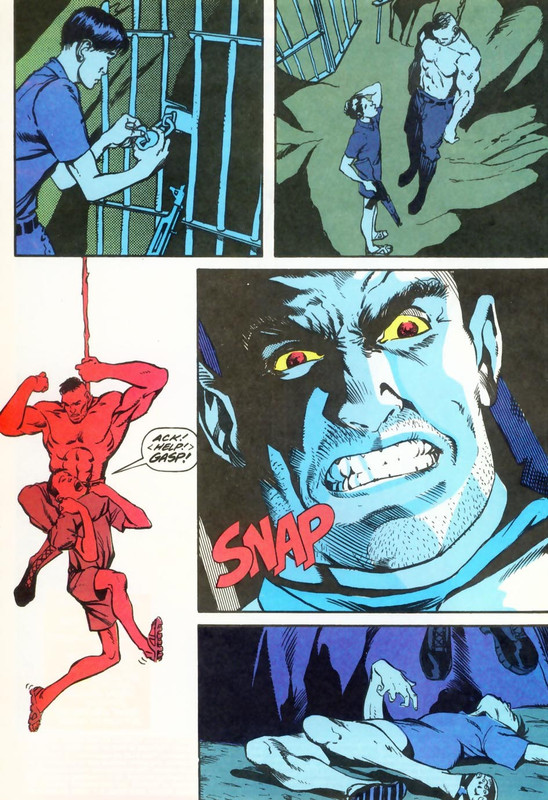 Frank Castle is sent out on a Phoenix program operation, is captured, imprisoned in a cell, inside a cave (metal bars, not bamboo) and then fakes a hanging and strangles to death, with his legs, a guard, when he investigates. He then bayonets a second and garottes a third, without raising an alarm. He then finds explosive charges and a convenient detonator, rigs the cave up and explodes the charges, burying the cave. he then leaves a dead PAVN soldier wired to a tree, as a warning. Of course, he is wired with det cord, which explodes when they try to take the body down. It's Hollywood BS of the Rambo variety. I cannot find any definitive record of writer Roger Salick being a veteran, though he was of draft-eligible age, during the tail end of the Vietnam War, having been born in 1952. However, that puts him at 18 when US troops began withdrawing from the war. A History.net article on The'Nam mentions him and Chuck Dixon as later writers, but does not indicate them as veterans, like it does Doug Murray, Wayne Vansant (Navy veteran of the Vietnam Era) and Don Lomax. My guess is no, much like Chuck Dixon, who did a lot of research, but never served in the armed forces. So, I originally said I was going to cover the Garth Ennis Punisher stories set in Vietnam; but after reading the first issue, I changed my mind. It was filled with inaccuracies and cliches and also an ignorance in the US Military of that era. Ennis has written a lot of great WW2 Era war comics, but based on extensive research. Given that I wasn't there either, I can't definitively say where he is inaccurate in details, though I have read several where it is obvious that he is embellishing for drama, but informing the story with history. That said, he is stronger with the British Army, as you would expect. With the Punisher, he is more concerned in placing the Punisher, as he knows him, in Vietnam, with a lot of Hollywood cliches and little actual history and I felt the same with his Nick Fury, which I was also going to cover. I personally hated his depiction of Nick Fury and I loathe the Punisher as a cheap Mack Bolan knockoff. Mack Bolan and his ilk were a reaction to Vietnam and the anti-war movement, as well as the political and socio-economic struggles in the Post-Vietnam Recession. The Punisher was just a copy of that type of character, which has its routes in the pulp heroes of the 30s, like The Spider and G-8, and, to a lesser extent, The Shadow. It's a mix of urban vigilante, hard boiled crime fiction and wish fulfillment. It does not make comment on the Vietnam War and society's experience during and after. It is just backdrop. On a similar note, I am not covering the Sky Wolf mini-series, from Eclipse, set around and during Dien Bien Phu, as it is also a pulp adventure story, using a historical setting for the adventure. It is no more a real account of things than The Wind and the Lion is a real account of Mulai Ahmed el Raisuni and the abduction of Ion and Cromwell Varley Pedicaris, in 1904. It is a pulp adventure fantasy, bending history to suit drama, rather than drama created around history. So, what am I covering in this installment? First, the mini-series Cinder & Ashe, by Gerry Conway and Jose Luis Garcia Lopez (PBHN) and their collaborators.     The series focuses on a pair of private investigators/troubleshooters: Jacob Ashe and Cinder Dubois. Jacob is a veteran of the US Marines, the Vietnam War, and several other battle zones, as a mercenary. Cinder is half Vietnamese and half African-American, the child of a Vietnamese mother and African-American soldier, serving in Vietnam. Their story is greatly centered around their past, in Vietnam, which is why it is included, because that past can't be separated from their present, like in the case of the Punisher or the superhero stories. That past defines them and haunts them and is central to the plot. Ashe isn't just a combat veteran; his life has centered around experiences in that war, as does his relationship with Cinder. She was born in Vietnam and is one of the many innocents whose life was destroyed by the war and she also serves to inform about issues raised in the wake of the war, though indirectly and highly fictionalized and unique. As the story begins, we see Cinder enter a locked cemetery and meet with a group of bikers, to deliver a ransom for a kidnapped woman. The woman has been sexually abused during her captivity and the bikers intend to do the same to the beautiful Cinder. That is, until she knees the leader in the groin and and takes down another with s piked heel back kick and a shot to a gas tank of a motorcycle, which somehow ignites the gasoline (Hollywood!) which keeps the others back, as she grabs the victim of the kidnapping. Ashe slams through the gate in a Cherokee 4x4 and fires a Micro-Uzi submachine gun at the gang members, until Cinder and the victim are able to get into the vehicle and escape. We learn they were hired by a wealthy man, who physically abused his wife. They take their large fee and then inform the client that the wife is under their protection, from him. He starts getting aggressive with Ashe, poking him repeatedly, while emphasizing a point, despite Ashe's warnings (and Cinder's) not to do that. They leave with their money and the client screams from a broken finger.  Ashe is a Cajun, the son of a Marine, killed in Korea and raised by his mother and loving stepfather. His dialogue is filled with Cajun inflections, though they sound like Conway used chef Justin Wilson as his guide, rather than any actual Cajuns. However, it adds a language connection between Ashe and Cinder, as he would have been able to communicate with the young Cinder, who he first encounters, as a small child, in Vietnam. After arriving at their New Orleans home, Cinder and Ashe meet Wilson Starger, a farmer from Iowa, whose daughter has been kidnapped. He was pointed towards the pair by an old Vietnam friend of Ashe's. Starger is a WW2 vet and dairy farmer, whose life went well, until recently. His dairy herd was poisoned and his credit was cut off at the feed & grain and the bank called in his loan. Then, he was attacked, in town, while his wife, in hospital, received a letter from a dead sister. Finally, he got a terrified call from his daughter, Jennifer, who was studying at Tulane University. She has been kidnapped and he asks the pair to help. He says he will sell everything he has to pay their fee. The pair agree and tell him that their fee is one dollar. As Starger departs, a shot rings out, hitting a passing truck, with drunken teenage boys out raising hell. Another follows and they realize it is a sniper. The eventually determine the shooter is a man named Lacey, a CIA agent in Vietnam, who has a past with Cinder. The pair investigate the kidnapping and the misfortune that befell Starger and find that records of May, 1978 are missing. They succeed in tracking down Jennifer and discover her dead, at the hands of Lacey. They further find a clue in a garage repair bill receipt, from May f 1978, but the garage's records are gone, when they check with the owner. Starger is shot and hanging on for life and Cinder sits with him, while in a hallucinatory state, he believes she is his daughter, Jennifer. She coaxes him into telling her what happened that May, in 1978 and learn that he stopped to pick up two young hitchhikers, in a rainstorm, in Iowa. They were a boy and a girl and they were run down by a speeding car, in the middle of the road. The car drove away, at high speed and it was hours before Starger flagged down help, as the speeding car had crashed into his truck, when it impacted the teens. He recalls a personalized license plate, which said "LEGAL" on it. They determine that the plate belonged to Harrison Wayne, a Congressman, who is running for the US Senate. They come to learn that Wayne's financial backer hired Lacey for damage control, as they were afraid that the increased scrutiny of a Senate race might uncover the hit-and-run. In a vicious battle, in Washington DC, which climaxes at the Vietnam Veterans Memorial Wall, Cinder exacts her revenge on Lacey. On the surface of things, it sounds like Vietnam is just character background, just like The Punisher; but, that background is woven through the story and informs the situation and the characters. We learn of that past via flashbacks, starting with Cinder realizing, in issue #1, that Lacey is the sniper, in New Orleans. She finds herself returning to Saigon, in 1963, in an apartment, with her Vietnamese mother and African-American soldier father. the proud papa is in love with his little girl and sees nothing but a bright future, while mama smiles and just quietly agrees with the man's rambling dreaming, knowing the reality isn't likely to match. He says that as soon as he has his discharge, they will marry and open a shop and live happily ever after. he is sent back stateside and never returns, as the mother knew would happen. Cinder's memory is her daddy saying he will never leave her, just as he does, never to return. 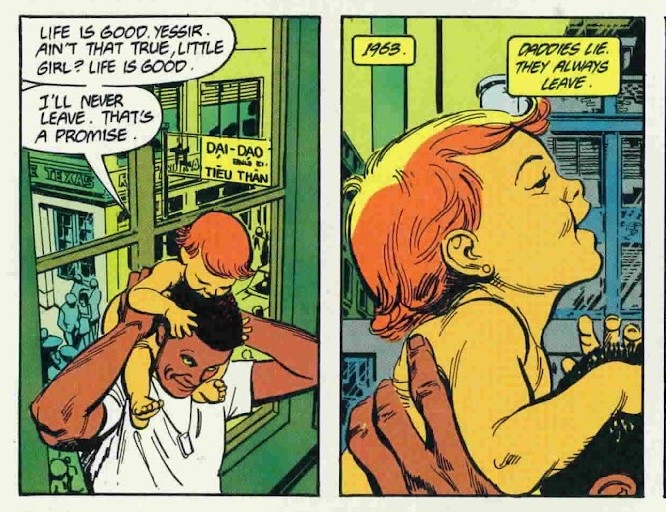 This speaks to a major issue relating to the war. Many American servicemen came to Vietnam and found comfort in the arms of a woman. Many spoke of marriage and many fathered children. Then, they were sent home and never returned, never brought their girl's to the US and never saw their children. Vietnam was no paradise of cultural acceptance, anymore than Europe or America and mixed race children were often viewed with shame and hatred and treated horribly. Vietnam, like China and Japan, had a history of treating ethnic minorities horribly, such as the montagnard peoples, who were abused and killed by North and South alike. They treated half breeds even worse and a child of an African-American soldier was the most taboo. The same was true in Korea and Japan. Take the example of Erika Shishindo, who was born of a Japanese mother and an African-American father, who "worked with the Army" at a nearby airbase (unsure if that means a soldier or civilian contractor). Her parents lived together until she was age 5 and her father was returned to the US, leaving them behind. Her mother was ostracized from her family and from society and had to raise Erika alone. She was brutally bullied and harassed in school, because of her looks and mixed race background. The bullying led to fighting, which then led her mother to recommend her to learn karate, to defend herself. the martial arts became an outlet for her, as did volleyball and Japanese women's professional wrestling. She trained to wrestle with the All-Japan Women's Dojo and became a professional wrestler, known as Aja Kong, one of several violent monster heels, where her larger physical status and exotic look accentuated the gimick. She became a massive star in a period where women's wrestlers were huge cultural icons, especially to young girls, as athletes and pop stars. However, her gimmick was still racially charged, as the "Kong" name was meant to invoke King Kong and the comparison of her ethnic hair to the giant monster ape. The Kong name has been applied to other African-American wrestlers, in Japan. We also develop a problem with the way Garcia Lopez (PBHN) depicts Cinder. Leaving side the orange coloring used to denote her Asian heritage (similar to the coloring of Shang Chi, in Marvel's Master of Kung Fu), she has red hair and no signs of her African-American father. This is how Aja Kong appeared, with her face paint worn off....  Compare that with Cinder in the above two examples. Now, the red hair would seems to suggest a Celtic heritage, though that wouldn't be entirely accurate, either. Red hair is due to a gene mutation in a melanocortin receptor, affecting melanin levels in skin and hair pigmentation. Red hair usually manifests when both parents are carriers of the gene. For instance, in Ireland and Scotland, 35% of the population carry the gene; but, only 10% manifest red hair, because the requirement of both parents to carry the gen and pass it on. The trait occurs more in cultures where strong sunlight is not a factor in the environment. It has occurred in Africa, but appears to have died out relatively quickly, due to harsher environmental factors. It does pop up quite a bit in Caribbean cultures, where intermixing of African slaves and their descendants and European slaveholders and colonists and descendents has occurred, across generations. In African-Americans, it is fairly rare, but does occur and is often coupled with other pigmentation anomalies, due to reduced melanin. So, we have a scientific basis to accept the red hair, though Garcia Lopez's (PBHN) character design ends up not really capturing other African-American traits and isn't particularly strong on the Asian traits. If it wasn't for the orange coloring, provided by Joe Orlando, we would assume Cinder's father to be of European ancestry. As it is, there is a line about a Scots grandfather, which factors more into Gerry Conway's heritage than anthying we learn about the characters. We never get to see Cinder ostracized because of her appearance, though, nor her mother, for having a mixed race child. We then move to 1968 and the Tet Offensive, where Ashe first encounters the little girl, as rockets hit the city. he carries the young girl to where her mother is, when she is killed by a rocket explosion. They are treated by medical response teams and Ashe remarks that the girl doesn't cry and just stares off, hauntingly..... 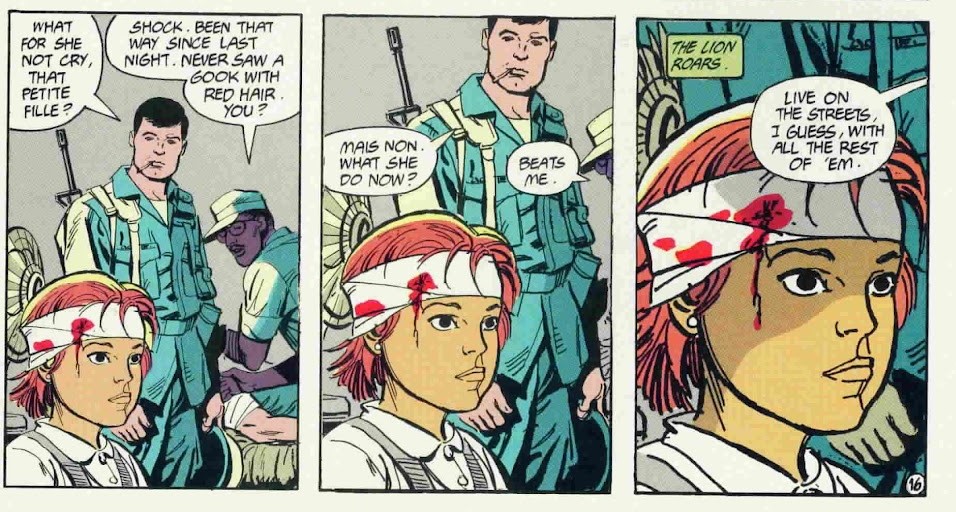 We then learn that Cinder survives, on the streets, as a thief, stealing money from inattentive GIs and fighting off rival gangs, before she is rescued from a beating by Lacey, who works for the CIA. He also runs several criminal enterprises, including a bar and brothel. Later, she steals for Lacey, for a place to stay, along with her friend, Khahn, a woman who is one of Lacey's prostitutes. Both fear him, but need his protection. Lacey abuses them and eventually rapes the teenaged Cinder. Cinder is haunted by the terror of Lacey and the rape and he has come back into her life, on this case. Meanwhile, Ashe was haunted by visions of the child Cinder, who ups and disappears, after being treated. We see flashbacks to his boyhood, in Louisiana, fishing with his step-father. he then joins the Marines, like his birth father and is sent to Vietnam. He loses friends in action and ends up in Saigon, during Tet, when he encounters Cinder. Ashe returns home, then continues with a military career, but we have continuity problems, as Ashe joined the marine Corps, but is shown returning to the US in an Army uniform and further assignment with the Army, in West Germany, in 1973. In 1975, he is part of the troops sent in to evacuate American citizens and vulnerable Vietnamese officials and families from Saigon, as the PAVN approaches the city. Again, we have continuity problems as the forces deployed were primarily the Marines, as the evacuees were ferried to US Navy carriers. We see the chaos of Saigon, as people flee and opportunists loot. Ashe sees the people clamoring to be let into the US Embassy and other extraction points, blocked by US Marines and Vietnamese soldiers. He spots a girl and thinks of Cinder and goes out into the streets hunting for her. Lacey leaves, drunk, after refusing to take Kahn with him. Cinder tries to get her to go with her to the embassy, to try to get out, but witnesses Khahn cut her own throat, in despair. The grief-stricken Cinder grabs the straight razor and goes after Lacey, tracking him down to the street and attacks him, but only gets a slight cut of his neck before he shoots her in the shoulder. He has her prone, at gunpoint, when Ashe arrives to save her.....  Ashe gets her out and returns with her, to the US, where he brings her to live with his closest living family, Jean-Marc and Angelique Dubois. However, Ashe then leaves, to go on with his military life, working for the US, with hints of covert operations, as well as mercenary work in hot spots like Angola. Cinder is raised by the Dubois family and does well in school and graduates magna cum laude from Tulane. While a student, she spots a fellow female student try to steal a pendant of hers. It is supposed to be a Purple Heart, given to her by Ashe, but Garcia Lopez (PBHN) doesn't seem to have had the reference or else Conway wasn't clear about what it is supposed to be, to him. It is drawn as a gold heart, with the word "Merit" inscribed on it. Ashe comes to see her, when contacted by the school, about the incident. The girl was a thief, but she also refers to Cinder, with a racial epithet, starting with "G". They talk and she then asks Ashe if he wants to sleep with her and he tells her if that is what she thinks, she doesn't understand him, at all. Later, at her graduation party, they go for a walk and she kisses him, full on and they start to move to the grass to make love, then stop, both realizing that it isn't how they really feel for one another and it would not work. However, that leads Cinder to present the idea of Ashe applying his skills in something he can believe in, as he is so disillusioned with the world. She suggests they become troubleshooters to fix people's messes, who will pay handsomely for it to be done and which might involve a certain amount of danger. Thus, for the wealthy who need them to clean up or stifle their messes, they charge them a bundle. For the poor, they offer their services for a token fee, as with Starger. In the end, the battle with Lacey takes them to the Vietnam Veteran Memorial Wall, where the slabs of polished stone reflect their fight, witnessed by the names of the dead and missing, in a place of healing. Cinder kills Lacey and is now free of him, but still not healed. After they meet with the recovering Starger, to relate the whole story, he tells them that now he can feel the tears over his daughter's death and begin the healing and tells them they need to do the same. As they walk away, Cinder stops and asks Ashe to hold her, as the tears come, for her mother, her absent father, Khahn and herself, as well as Jacob. 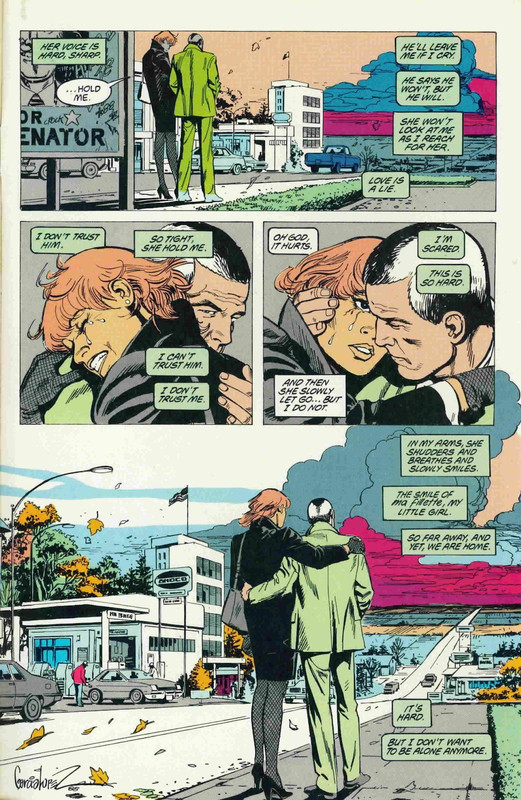 From a historical perspective, this story is full of holes, inconsistencies and stereotypes. Gerry Conway was not a veteran, was not in Vietnam and didn't bring any firsthand knowledge. He also didn't do a ton of research. His script has tons of inconsistencies, like Ashe switching from Marine to Army soldier, as well as no real grounding in the events in Saigon, in April 1975, beyond the news reports. From a dramatic standpoint, it some of his best work. The characters are intriguing and draw you into the story and he crafts a good mystery. The problem is one of originality, a problem that has dogged him, in his career. Gerry Conway started very young, as a writer and made a lot of mistakes, in his career, especially in his brief tenure as Marvel's EIC, where he acted like a spoiled child, taking books away from writers because he wanted to write them and draw pay for it, while being paid as the boss. That didn't make him any friends. However, that was as an editor. As a writer, he often failed to do much research and just went with what he thought he knew and would make glaring errors in geography, history and logic. He also took ideas from other sources, and not in an "inspired by" way. The Punisher was a blatant swipe of Mack Bolan, which dominated paperback racks in the 70s, alongside the likes of Doc Savage and The Shadow reprints, Conan, Burroughs reprints and modern pulp novels of detectives, guns for hire, vigilantes and crime fiction. He gave him an origin that basically whited out Mack Bolan's name and inserted Frank Castle, minus a kid brother and a sister who is forced into prostitution, by the Mafia. Enough was changed to prevent a lawsuit, but not much. Cinder & Ashe is pretty much a pastiche of Modesty Blaise. Like Modesty, Cinder is a tough, capable woman, orphaned at a young age, in a war, who survived on the streets and among criminals, who rises above and creates her own world, earns her fortune, retires and then helps those in need. Ashe is Willie Garvin, to loyal lieutenant who serves his "Princess" and whose darker tendencies are negated by Modesty's light. Both are experienced and highly capable soldiers, with no revulsion in killing, though they have seen loss in battle. They are adrenaline junkies, who find a way to focus it for the good. There are differences; Modesty is the leader of their duo and the strategist, while Willie is the arms expert and superb hand-to-hand fighter. Modesty is well trained, but learned to fight to survive and is a nastier fighter. She was also raped and abuse and learned to shut off the reality, to save her mind, then unload emotionally, when it is safe. many harrowing adventures ended with Modesty in Willia's arms, having a good cry, to release the stress and emotions, just like cinder. Modesty and Willie are not lovers and say it would never work, when people ask. The same is true of Ashe and Cinder. However, Ashe is more the leader, though it fluctuates, based on the situation. Tactically, he is in charge, but, philosophically, Cinder leads. What really elevates this is Garcia Lopez's (PBHN) art. JLGL is an artist's artist. The man wasn't fats, so a monthly series was rarely in the cards for him. He did a lot of Superman-related stories, then would pop up here and there. However, he became the definitive artist on the DC heroes, via his work at creating the stylebook for use in commercial licensing of the characters. He created character designs to maintain consistency in licensed products, like t-shirts and lunch boxes. His designs were used for the Super Friends series Legendary Super Powers and Super Powers Team: Galactic Guardians. His stuff is gorgeous and he knows how to tell a story. He also excels at capturing the real world and when he gets an assignment that lets him inhabit that world, he goes to town. There are no superheroes in Cinder and Ashe and he makes it stand with the best adventure comics of newspapers and comic books One thing this doesn't reflect, though, is the average refugee experience. there were many Vietnamese children adopted in the US or given foster homes, as well as whole families sponsored by Americans. Many were not and escaped Vietnam to Cambodia and Thailand, bribing officials and surviving pirate attacks, in attempts to escape the war zone. Cambodia's own war and the Khmer Rouge genocide of political opponents and others made things worse. The saga of the "Boat People" was world news, with nations squabbling over taking in the refugees. The US ended up taking more than anyone else, but had to be shamed into it. Australia also received large numbers, but had a troubled relationship with the Vietnamese community, as years went on. Similarly, Asian immigrants faced harassment and racial prejudice in America, as well as as a reminder of the war. Aside from the girl who steals Cinder's necklace, calling her the G word, we don't get much of a sense of that. That is where Conway's writing falls short. The series is a bit over-written, with narration of inner thoughts dominating, rather than letting JGL's (PBHN) images convey the story. It is a common fault of several of the writers of Conway's generation, including his mentor, Roy Thomas. Cinder & Ashe is an adventure drama, one following in the traditions of pulp fiction, but Vietnam is central to the characters and the plot, showing how big a shadow Vietnam had, by the mid-to-late 80s, when this was published (1988). WW2 and Korea became deeper history and Vietnam became to backdrop or background for modern adventure heroes. I mentioned two features and the second will follow, in Part II, after I make and eat some dinner. Back in a little while! |
|
|
|
Post by foxley on Jan 17, 2024 22:22:15 GMT -5
The bulk of my collection is in storage at the moment, so I can't check to be certain, but I believe there is a single throwaway reference that mentions Cinder's red hair is a legacy of Scottish grandfather (or possibly great-grandfather).
|
|
|
|
Post by codystarbuck on Jan 17, 2024 22:27:48 GMT -5
The bulk of my collection is in storage at the moment, so I can't check to be certain, but I believe there is a single throwaway reference that mentions Cinder's red hair is a legacy of Scottish grandfather (or possibly great-grandfather). I recall that too........ somewhere...........  |
|
|
|
Post by codystarbuck on Jan 18, 2024 1:28:37 GMT -5
Mmmmmmmmmm......spaghetti..................... Or as my Anglo-German-American grandmother would say, spaghetta........ Part 2 I'm not going to spend a huge amount of time on the second feature, because I covered it, here, in my Jon Sable, Freelance thread. However, I want to discuss the theme of the issues.   Missing and unknown dead have plagued armies for centuries. Sometimes, a body could not be identified, especially after gunpowder became involved in conflict. At the end of World War 2, some 78,000 American servicemen had been listed as missing in action, making up 19% of total US casualties. At the end of the Korean War (or rather, after the cease fire led an end to direct combat), there were over 8,000 unaccounted for. In 1973, government estimates of Americans held in captivity was around 1300, with another 1200 listed as "killed in action/body not recovered." After the signing of the Paris Peace Accords, 591 American POWs were released and returned to the United States. By late 1973, some 700 remains of American servicemen had been returned. In earlier wars, identifying bodies was a difficult task, as dog tags were not standard issue until WW1 and even then could be lost. As decades progressed, new identification techniques made identification easier, though not perfect. DNA testing and recording has improved that. Still, that assumes remains are recovered. Many died in circumstances that left little remains. Planes and helicopters crashed in remote areas, without definite locations recorded on maps. POW families became part of associations, leaning on each other for support and information. The National League of Families of American Prisoners and Missing in Southeast Asia began in 1966, in Coronado, CA, as a support network for local families, but grew into a national organization. It was started by Sybil Stockdale, wife of Navy CDR (later Admiral) James Stockdale, the future VP candidate alongside Ross Perot, as well as other POW wives. Their aim was to highlight the mistreatment of American prisoners of war, in the hands of North Vietnam. Their activism led to better treatment for their husbands and others, as North Vietnam faced greater international pressure for humane treatment of prisoners. After the war, their mission became those that did not return home and/or remained unaccounted. They became a large lobbying group, pressing the MIA issue to gain a full accounting from the government. In 1973, President Nixon claimed that all American prisoners had returned home, despite that not tallying with their estimates, especially in regard to those who went missing in Laos, during the secret war there. There were additional numbers unaccounted for from other secret operations, like the Phoenix Program and the Shining Brass recon teams. Exacerbating the issue was the Nixon Administration elevating the number of missing to add emphasis to political promises to see the return of all Americans. Nixon would not admit that he hadn't achieved that and dodged the issue. Since the war, there have been missions to Vietnam, Laos and Cambodia to locate and identify American remains, from the 1990s onward. In 1991, a committee, chaired by Sen John Kerry (a Vietnam veteran and member of Vietnam Veterans Against the War), along with senators Bob Smith and John McCain to investigate the matter. Across 2 years, they questioned former administration officials and conducted fact finding missions in Vietnam, Laos and Cambodia, examining their records. They found that the Nixon Administration believed more prisoner were unaccounted in Laos, but they found no compelling evidence of any living POWS. One of the driving forces of a military unit is the idea of not letting down your buddies. William Earhardt described the constant fear during his time in Vietnam, not of being hurt or dying in combat, but of letting his buddies down. It took him years to realize that they felt the same and it drove their actions, both heroic and otherwise. One of the greatest sins in the military is to leave a man behind, alive or dead, as it is akin to abandoning them. As such, the MIA issue was and is of great importance to servicemembers and veterans. For years, vets and others flew the POW/MIA flag, wore bracelets commemorating those listed as MIA and working with fundraising efforts to gain an accounting. Mike Grell is a veteran of the US Air Force and was stationed in Saigon, where he worked as an illustrator. He enlisted in the Air Force for a 4 year commitment, to avoid being drafted into the Army. One of his primary jobs while in South Vietnam was to illustrate briefing materials for military authorities, which were then used to educate diplomats, government officials and the press. In Mike Richardson & Steve Duin's book, Comics: between the Panels, Grell spoke of carrying a guilt, for years, because of top secret information he saw, in those briefing materials, about the drawdown in US forces, in advance of their actual occurrence. he saw it all, the planned withdrawal, while others continued fighting and dying, while the government planned on pulling out. Mike Grell's Vietnam experience informed two of his creations: Travis Morgan (aka The Warlord) and Jon Sable. Morgan was a USAF Sr-71 pilot, during the Vietnam War, conducting covert reconnaissance of the Soviet Union, when his aircraft is hit by a Soviet surface-to-air missile and goes down somewhere in the Arctic Circle, only to find himself parachuting into a tropical world, seemingly beneath the Earth's surface (actual across a dimensional gate). With Morgan, the connection was the service and the period, but that was quickly left behind for a Burroughs pastiche of sword, sorcery and adventure, in a lost world. Jon Sable was a little different. Originally, it was an idea for a hard boiled private detective, in the vein of Mickey Spillane's Mike Hammer, to be called Iron Mike. It morphed into a mixture of Hammer, James Bond and Peter Capstick's books on hunting, in Africa,. Sable became a sportswriter and hunter, a former member of the US Olympic Team, in the Modern Pentathlon, who marries a Kenyan woman of European heritage, with whom he moves to an area on the Rhodesian border, to start a safari business. To make ends meet, as the Rhodesian Civil War has increased poaching and driven away tourism, he takes a job as a game warden. In that capacity, he comes across poachers and interrupts their operations, leading its leader to target him and his family. his family is killed in an ambush and he spends his time hunting down and killing the men responsible, living in the bush, losing more and more of his humanity. He appears to gain some measure of revenge, descends into alcohol abuse, then gets cleaned up and ends up leading a police secutiry force, in the bush...basically acting as a mercenary. After majority rule, he is kicked out and returns to the US and tries to write his experiences, but finds no one is interested. He ends up offering his services as a mercenary and a high profile child killer hunt, where he tracks down the killer, leads to extensive publicity and much more work. meanwhile, a literary agent keys in on the stories he would tell his children, about leprechauns in Central Park and is able to sell it as a children's book. Sable then lives a double life as Jon Sable, bodyguard and gun-for-hire and author BB Flemm, forced to wear a disguise for public appearances. One of the supporting characters introduced is retired Hollywood stuntman Sonny Pratt, who trained Sable in fencing, for the Olympics. He was a stuntman in many swashbucklers and has a habit of showing up in Sable's home, dressed as Zorro or D'Artagnan, interrupting Sable and lady friends. In one story, we see Sonny go to deliver Christmas presents to his grandkids, only to be turned away by their mother. In issue #12, we learn why. Sonny's son was a fighter pilot in the USAF, serving in Vietnam. He was shot down and declared missing in action. Sonny believed him to be dead, as years passed, but his daughter-in-law was unable to move on with her life and they grew apart. Jon decides to finance his own search-and rescue mission to Vietnam, and contacts an old friend, former Green Beret, named Jerry, who recruits a former ARVN colonel, who acts as interpreter and guide. They meet in Bangkok and then infiltrate Vietnam, near the Laotian broder, uncover a hidden weapons cache (placed there by the ARVN colonel's men, and then enter Vietnam through Quang-Tri Provence and then north through the DMZ, to the area where Bill Pratt's plane went down. 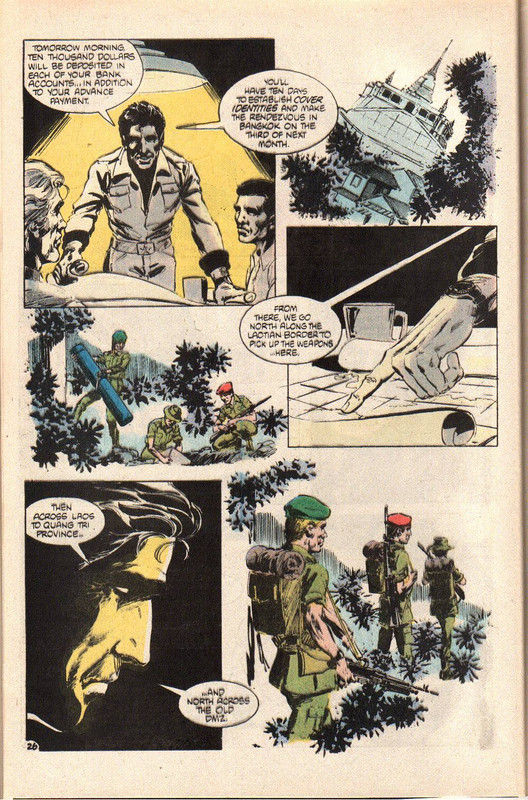 In the 1980s, the MIA issue was in great debate and the media latched onto it, as America started to come to grips with the legacy of the Vietnam War. It made for a great human interest story, as journalists interviewed families of those missing, who wanted some final concrete evidence of the fate of their loved ones. Out of this grew a group of people who sought to seek answers....or fleece the desperate out of their money, retired Air Force Lt Col Jack E Bailey started Operation Rescue, with a former freighter and smuggling boat, the SS Akuna, and financed it through solicitations of POW/MIA families. Apart from a minor rescue of some boat people, his group accomplished nothing and reports emerged of the Akuna never leaving Thailand and that money raised funded further fundraising, with extensive skimming and gross exaggeration of Bailey's military record. Former Special Forces Lt Col Hames Gordon "Bo" Gritz led privately funded missions into Laos and other parts of Southeast Asia, with no success, though, again, reports came of these missions indicating comical efforts, such as women selling t-shirts, in border towns, asking for information, rather than actual infiltration of recon teams, like he claimed. grell even name drops Bo Gritz in the story, as Jerry asks Sable why he thinks they will find anything, when Bo Gritz couldn't? Writer JC Pollock, himself a former member of Special Forces and the Special Operations Group, in 1982 wrote a novel, titled Mission MIA. The plot features a former Green Beret captain whose best friend was captured in Vietnam, in Quang Tri, when the PAVN over-ran the Special Forces camp there. The man's wife receives word from some escaped Vietnamese POWs that her husband and a couple of other Americans are alive and held in a prison camp, near Laos. The protagonist them reassembles the remains of his A-team and they train for and execute a rescue mission, with financing from the wife's father, a businessman. They assemble in Thailand, where the CIA siezes their equipment and warns them off. They break into a warehouse and steal it back and carry out the mission, with the help of some mercenaries/drug runners. They locate the camp, launch an assault and effect a rescue, but find themselves trapped when the mercs won't pick them up. They end up being pulled out by a CIA-run mission. The plot had many similarities to the 1983 movie, Uncommon Valor, starring Gene Hackman, featuring Fred Ward, Tex Cobb, Tim Tomerson, Patrick Swayze, Reb Brown, and Harold Sylvester, as well asd Robert Stack, as the man financing the operation, whose son was also missing, along with Hackman's. The film was based on a screenplay originally written by actor Wings Hauser, who sold it to paramount. John Millius became attached as producer and had a rewrite done by Joe Gayton. Hauser later accused Millius of stealing the script. The filmw as directed by Ted Kotcheff, who also directed First Blood, the debut of Rambo.... Throughout the film, Hackman spouts the conceit that they won the battles but lost the war. He tells the men that they lost the war, they cost too much and didn't show a profit, so they pulled out. he talks of the decision makers not having sons in Vietnam. It was a nice fantasy, but the reality was likely that those missing were probably dead and their remains were claimed by the jungle of Southeast Asia. Conspiracy theories abound of US prisoners continuing to be held in exchange for war reparations, demanded by the Communist government, a promise that was reneged by the Nixon Administration. It gained a lot of traction with very real Nixonian conspiracies, such as the Watergate break-in and the use of the FBI to infiltrate the anti-war movement and provoke them into violent acts that would discredit them. By the 80s, it was easy to believe that Nixon knew there were American POWs in Vietnam, Laos and Cambodia, even China or the USSR. Later, bris Yeltsin claimed it was likely that some were transferred there, for interrogation, but their records were incomplete, but Yeltsin was hardly a credible source on KGB activities. Issue 12 features much about Sable's Vietnam experiences, which were likely based, in part, on Grell's experience, or stories he heard. Sable is a clerk typist, in an admin billet, similar to Grell's, as an illustrator. Sable is stationed at an airbase, near Saigon, a base subjected to rocket attacks and there is a warning system of a Vietnamese cleaning woman, known as Mama-san, who is a known VC sympathizer. if she doesn't show up for work, an attack is imminent.  Jon has a nightmare about it, where an airman, named Sayble, with orders home, is killed in an attack. Later, we see Sable in the middle of a New Year's party that turns into a brawl, with Sable hiding under a table, until rescued by Jerry... 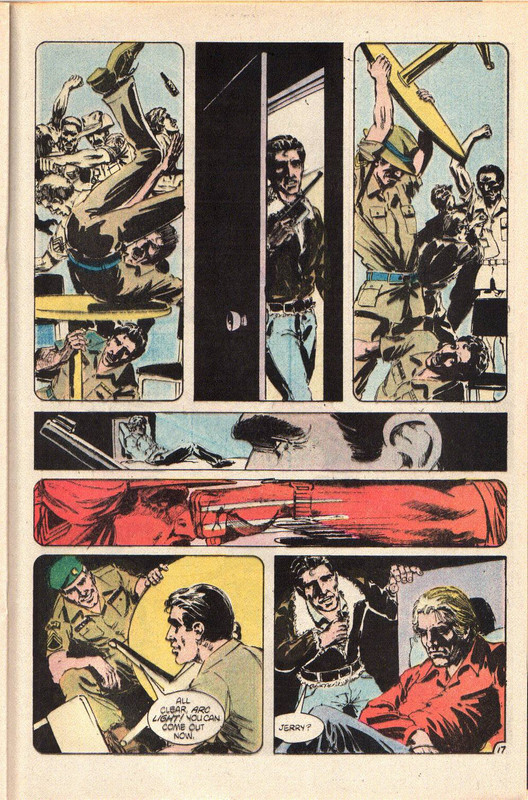 The flashback illustrates how much Sable has changed, from hiding under tables, during a brawl, to leading a covert mission into Vietnam, after years of a bush war in Africa and mercenary work since. The story is not only about an accounting for the missing, but it becomes about redemption and finding a piece of themselves, left in Vietnam. The ARVN colonel, Nguyen Van Tran, reminds us of the Vietnamese refugees, who didn't exactly find better lives in America and elsewhere... 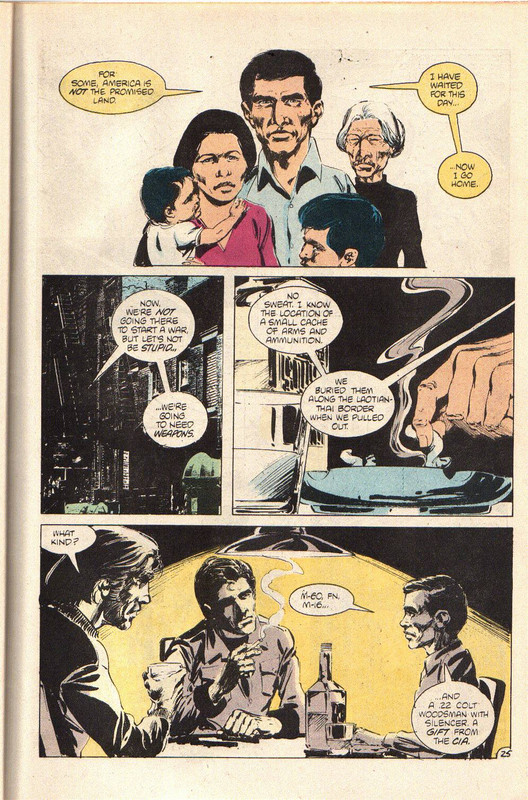 In issue #13, the men spend 9 days searching, but no luck. Sable and Jerry discuss their losses and coming home from the war. Both admit, though, that they missed the adrenaline of combat, a subject which many veterans have admitted, reluctantly. This is a recurring theme in Jon Sable, as he is tormented by dreams of his loss, yet constantly seeks danger and excitement. At first it seems suicidal, and likely was, but it has grown to be about continuing to live for that rush of adrenaline. It serves to wreck his relationships, as his partners are afraid to get to close, while he keeps them at arms length, lest he bring them death or harm. Sable turns out to be suffering from a bout of malaria, having lost his supply of preventative medication in a river crossing. He is then injured by a water buffalo that is spooked and he shoots down, but not before it crashes into him. The shot draws the attention of an army patrol and the men must move out quickly; but, Sable falls behind, but doesn't call out. The others are forced to abandon him and he is capture and subjected to torture... 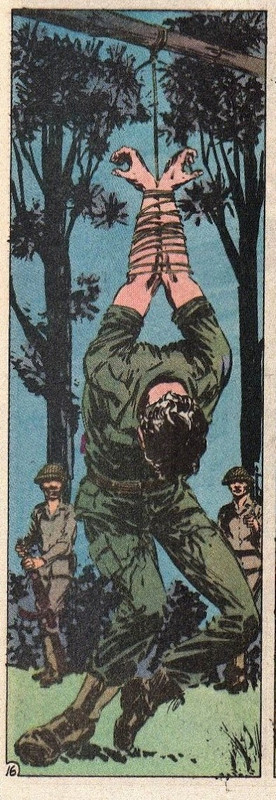 The torture shown was based on actual methods used by the VC and PAVN on captured soldiers and similar used by other armies. Sable is rescued by Jerry and Tran and carried out to a montagnard village, where they hole up and treat Sable's wounds. his fever breaks and he recovers and they discover that the hooch they are in was built with parts from a downed aircraft, from the area. A section bears the registration number of Bill Pratt's airplane. A local guides them to the place and says the pilots bailed out and one, a redhead, was captured (the radar officer, Rusty Olsen) and the other died. They find the remains, with dogtags that identify it as William Pratt, USAF.... 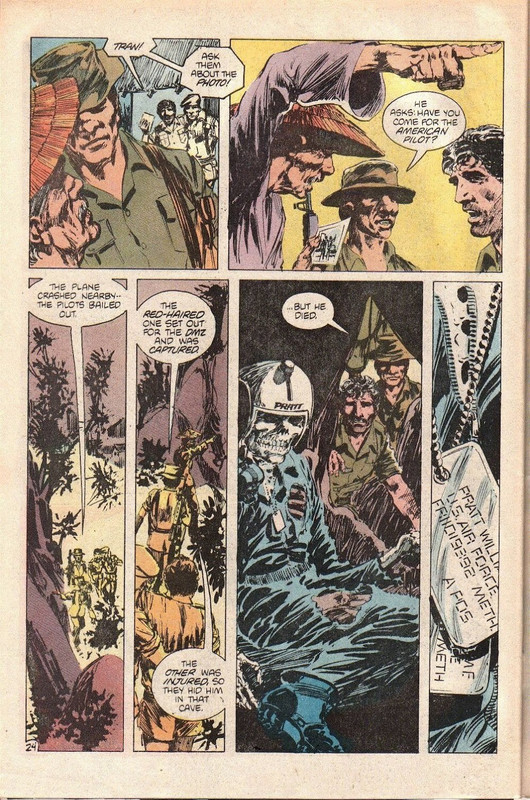 They return to the US and deliver the news to Bill Pratt's wife and Sonny. Now, they have closure. However, as they head for their rendezvous with an extraction boat, they miss seeing a man toiling in a field, who has red hair, implying that he is Rusty Olsen, who is alive and others may be, too. One of the opening hooks to the story is a smuggled list of American POWs and letters from them, which comes into the hands of Rennie Davis, a prominent member of the anti-war movement. This was based partially on an actual propaganda approach, made by North Vietnam, to the anti-war movement, to orchestrate the release of some American POWs to the movement, to then discredit the government and increase anti-war sentiment. Davis was involved in attempts to disrupt the 1968 Democratic National Convention, in Chicago, which led to his arrest and trial as part of the Chicago 7. This element of the story was informed by editor Mike Gold, who was involved in the anti-war movement, in Chicago, as well as the defense of the Chicago 7. So, the story reflects both the military side of the war and the civilian activist side and the story is dedicated to "Those who fought the war...over there and at home." In that, you see a certain respect for the anti-war movement to bring an end to the war and the safe return of American soldiers. unlike Doug Murray, Grell isn't carrying a resentment about things like the protests and the media. Interestingly, I listened to William Earhardt, on a podcast, talking about his poems and his experiences, including as a teacher, trying to counter Reagan Era efforts to distance America's actions in Latin America and elsewhere from Vietnam, as well as his experiences in participating in Ken Burns documentary of the Vietnam War, as well as the WGBH Boston documentary, Vietnam: A Television History, broadcast by PBS, in 1983. he had high praise for the latter, but not the former, as it paints the involvement in Vietnam as taken by misguided, but honest officials, rather than an extension of US expansionism and foreign policy. He talks about Smedley Butler and the banana Wars, comparing them to Vietnam and later actions in Latin America, in the 80s, as well as the Gulf War and War on Terror. I just finished watching the Vietnam War: A Television History series, on the Internet Archives. I highly redommend it, as it covers things from both sides, with those involved. it took its inspiration from the outstanding ITV documentary series, The World At War, which featured a look at WW2, both on the battlefield and homefront, on the Axis and Allied sides; not just the battles, but the political events and socio-economic lives. This follows that path and gives extensive background about the history of Vietnam and French colonialism, the effort to retake Indochina after the war, and the US backing of France during that war with the Viet Minh. It segues into the US sending military advisors and aid and escalating into combat troops, B-52 bombing missions, the secret war in laos, the invasion of Cambodia and the subsequent withdrawal and fall of Saigon and the aftermath. An entire episode is given over to the homefront and the antiwar movement, including footage from the 1968 Democratic National Convention and Chicago police attacking protestors with nightsticks and shoving them into paddy wagons, including a tiny middle aged woman (not beaten but arrested) who defiantly (and off key) sings "We Shall Overcome.." as the police try to close the door to a paddy wagon. The series features members of the military, State Department, defense department and even President Ford in interviews, with figures like Gen William Westmoreland, Douglas McArthur II (son of Caesar), Dean Rusk, Henry Kissinger, Gen Giap, members of the National Liberation Front (the Viet Cong), the ARVN, the South Vietnamese government, the French colonial government, British officers in charge of taking the surrender of the Japanese, who rearmed them to aid in the battle against the Viet Minh, even as OSS agents were trying to build a coalition and steer the Viet Minh to Washington, resulting in the first American casualty of Vietnam. Really compelling footage, showing bombing of civilian areas, evacuation and torching of villages in VC-dominated areas, the instability of the Diem government and subsequent governments (plus US involvement in the military coup) and much much more. Politically, it is far more balanced than the Burns' piece, especially in the eyes of Earhardt, who said his best stuff was left on the cutting room floor (he also praised Burns co-producer far more than Burns, who he only met at the premiere.) Anyway, I am digressing. Grell's stories are informed by experience and research, which is lacking in Cinder & Ashe. Also, Grell knows what he is drawing, unlike JLGL, though he does a fine job with what he is given. Grell is writer and artist and knows when to let the art tell the story, making it sparser on text. Still, both are great adventure stories, informed by Vietnam. Both illustrate how Vietnam had become part of entertainment culture, as more and more writings and dramas appeared, relating to the war and its aftermath. A few were also drawing the parallels between Vietnam and then-current Foreign Policy and actions. This pretty much closes out the 1980s period of comics, and their use and depiction of the Vietnam War. Missing is the series, In-Country, an independent series, later picked up by Blackthorne, because I have no copies or digital files of it and have little information about it. From here. we will move into a 1990s graphic novel series, which dramatically explored Vietnam in a metaphorical setting: outer space. Our next installment will examine Mark van Oppen's (aka Marvano) graphic adaptation of science fiction writer Joe Haldeman's seminal novel, The Forever War, an allegory of Vietnam, based on Haldeman's experiences as a combat engineer. Technically, it is a 1988 series, in Belgium, but not published and translated in the US, until 1990-1994 (in three volumes, by NBM). |
|
|
|
Post by foxley on Jan 18, 2024 1:56:48 GMT -5
If I ever get to meet Mike Grell at a convention again, I really want to ask him if that bit about about the brawl with Australian soldiers on New Year's Eve was based on something that happened to him in Vietnam.
|
|
|
|
Post by codystarbuck on Jan 18, 2024 2:52:35 GMT -5
If I ever get to meet Mike Grell at a convention again, I really want to ask him if that bit about about the brawl with Australian soldiers on New Year's Eve was based on something that happened to him in Vietnam. I'd bet on the hiding under the table part, as Grell was no taller than I am and I am 5 ft 6 in. Mike Gold, by contrast, is a big s@#$-kicker-looking dude. He told me about firing Elliot Maggin, at DC and then Maggin sucker-punching him, at a convention and people getting him away from Maggin, before he retaliated. Maggin described himself as a bit of a hothead, in interviews, so I don't disbelieve it, but I wouldn't want to take a poke at Gold, especially since he is a Chicago guy, who was involved in the battles with Richard J Dailey's police, for whom "fascist pig," was a compliment. |
|
|
|
Post by codystarbuck on Jan 18, 2024 13:12:49 GMT -5
Just a side note, for completion; I mentioned the Sky Wolf mini-series, from Eclipse. I have previously covered it here, in my Tim Truman and 4Winds thread.   A little background. Sky Wolf was one of several pulp aviation heroes appearing in Hillman's Air Fighters comics, in the 1940s, alongside Airboy, The Iron Knight (a British pilot who wears a suit of armor, in flight), Black Angel (British female pilot), The Flying Dutchman (just what it says on the marquee), The Bald Eagle and The Flying Fool. Sky Wolf was, more or less, a swipe of Blackhawk, as the hero led a team of aviators, in a "tri-plane" which would split into three sections. The hero wore a wolfskin, as a hood, along with leather flying jacket and adventure clothes. His companions were Judge, Cocky Roche and Turtle, who were pilots from other countries. When Eclipse and Tim Truman revived Airboy and the Heap, they brought in some of the other characters as supporting cast, but Sky Wolf stood out. He was an old, but tough old man, who worked as a mercenary pilot. He was then presented in back-up stories, when Airboy went from bi-weekly to monthly (doubling the page count, to boot). The stories featured Sky Wolf after WW2, as he gets involved in post-War conflicts and hot spots, eventually ending up in the middle of the Korean War, as well as places like China, during the fall of the Nationalists, occupied Japan, the Himalayas, Korea (as mentioned before), Hollywood, Texas (back home) and, eventually, Indochina. The impetus for some of these stories was Jack Gatling, aka The Bald Eagle, turning up at Sky Wolf's doorstep, with yet another wild story and a treasure hunt. That is how this mini-series comes about. Jack has been fling for Hollywood film productions and gets himself fired. he then goes looking for Sky Wolf and finds him in a bar, crying in his whiskey about his wife, Riot O'Hara, leaving him, after she saw he could never be a normal husband, any more than she really wanted to settle down, either. Gatling convinces Sky to come with him to hunt for 12 golden horses, intended as a tribute, in Vietnam, but stolen by bandits. Sky Wolf is usually drunk when he agrees to these adventures and wakes up, with a screaming hangover, in a plane, bound for some remote locale. In this series, it is Vietnam, in 1954, as the French are battling the Viet Minh for control of the country. After they arrive, they check in with local French authorities, including a Legion garrison. There they find several former German soldiers, including Sky's enemy, Baron Von Tundra. After WW2, France wasn't too picky about who they let into the Foreign Legion and many former Wehrmacht soldiers and even some Waffen SS joined up. More than a few ended up garrisoned in Indochina, where their skills and experience were exploited in subduing the Vietnamese nationalists. That was the main background of Chuck Dixon's story. The bulk of it is pretty much standard pulp adventure, with tough heroes, searching for lost treasure, which they find in an ancient temple. Of course, Baron Tundra double crosses them and, of course, they run into the Viet Minh. They eventually come across Viet Minh moving supplies along the Ho Chi Minh trail, headed for the besieged outpost, at Dien Bien Phu. Sky Wolf, Jack and Von Tundra end up having to seek sanctuary at the base and find themselves embroiled in the final battle to take the outpost. Sky Wolf kills Von Tundra, but he and Jack are taken prisoner, when the Viet Minh overtake the base and the French surrender. They are held as POWs until the release of the French and the signing of the armistice. Sky Wolf eventually returns to the US. There was one more back-up, where Sky Wolf is back in Texas, recovering from malaria, and he gets involved in chasing down some bank robbers, in Mexico. The battle at Dien Bien Phu is the main connection to the war, aside from the setting and the encounters with the Viet Minh, in the jungle. Had the series continued, it is likely that Sky Wolf would have returned to Vietnam, probably for the CIA, though he didn't like them, after dealings in China and a set up to kill him (which is part of why he wears a mask, after the war). Like I said, it is pure pulp adventure, placed in historical settings, with actual history being woven into the adventure. The Korean segments find him involved in the Battle of the Chosin Reservoir and other battles, and even brings in Sgt Strike, a WW2 super soldier created by Dixon and Tom Lyle. Dixon and Truman wove a whole little pulp universe for their stories, with characters like the 1930s hero the Prowler, as well as the Air Fighters, Sgt Strike (and the later Strike, a young man who finds the suit and power harness), and some characters from the republic serial Fighting Devil Dogs. They also did a story about Sky Wolf's father, flying for Pancho Villa. Dixon would go on to write some issues of The'Nam, focusing heavily on special forces soldiers, rather than regular infantry, as had Doug Murray and, later, Don Lomax. |
|
|
|
Post by codystarbuck on Jan 23, 2024 23:24:18 GMT -5
Joe Haldeman was born in 1943, in Oklahoma City, OK. His family moved around, quite a bit, and he spent parts of his childhood in Puerto Rico, Bethesda, MD; Anchorage, New Orleans and Washington DC. He married Mary Gay Potter, in 1965; and, in 1967, he graduated from the University of Maryland, with a degree in physics and astronomy. Then, he was drafted into the United States Army. Haldeman opposed the war and was a pacifist and even considered fleeing to Canada; but, his dream was to work for NASA and he knew that would kill his chances; so, he showed up at his induction center and went through boot camp and further training, before deploying to Vietnam, in 1968, as a combat engineer. He wrote letters home to his wife about the things he saw and experienced. His job routinely involved the use of explosives and the disposition of enemy munitions and explosives. A boobytrapped weapons cache resulted in an explosion and his injury, for which he was awarded a Purple Heart and given his ticket home.  After the war, he found home to be an alien place and he had troubles with things he had experienced. He sought psychiatric help and with therapy and lower and lower doses of psychiatric medicines, he coped. What really helped him cope, though, was the Milford's Writers Workshop. He was immersed in the craft of writing, surrounded by other writers and he found his true calling. What followed was a novella, called The War Year, published in 1972. It is a fictional account of Vietnam, but influenced by Haldeman's actual experiences and his letters to his wife. 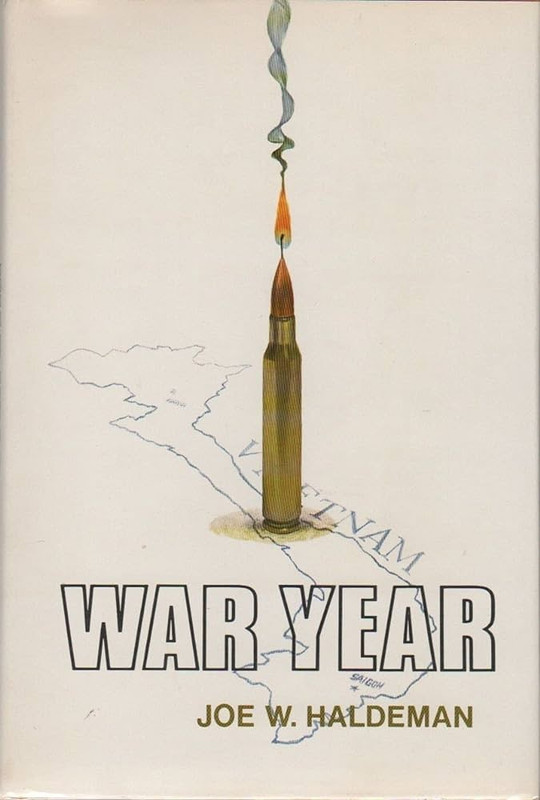 From there, Haldeman combined his experiences in Vietnam and his love of science and science fiction and what emerged was a project for his MFA thesis, at the Iowa Writer's Workshop. It was first serialized in Analog, before being published as a complete novel, in 1974, as The Forever War.  Here, Haldeman distilled the Vietnam experience, in a future setting, with the Earth at war with an alien species, from the area of space in the constellation of Taurus. The enemy has not been seen and little is known about it. The novel was also written as a counter-point to Robert Heinlein's 1959 military science fiction novel, Starship Troopers. Heinlein was a graduate of the US Naval Academy, in 1929, and served in the Nay for 5 years. It colored his view of the role of the military and he was a devout anti-Communist. The book was spawned in the wake of President Eisenhower suspending US nuclear testing, with the USSR continuing.. In it, Heinlein presents a world ruled by a military elite and only Federation military service can grant full benefits of citizenship. Most citizens are not franchised, but enjoy peaceful lives. However, only veterans have voting rights. The Earth becomes embroiled in a war with an alien race, known as "bugs" and the hero, Johnny Rico, becomes a member of the Mobile Infantry, a cross between a paratrooper and a Marine, with the soldiers using powered armor, to boost their fighting abilities. Haldeman, and many others, felt the book glorified war and presented a militarist POV. Haldeman praised the writing of the novel, but not the message. His work serves to present a combat soldier's POV, especially that of an unwinnable war, an unseen enemy, draftee soldiers, and alienation at home. The Forever War won the 1976 Nebula Award for Best Novel and the Hugo and Locus Awards for the same, also in 1976. Pre-1991 editions of the novel were abridged, by the original editor, missing the middle section, "You Can Nver Go Back". That section was restored in the 1991 edition. Further restorations, to resolve internal inconsistencies, appeared in 1997. In 1988, the novel was adapted for a graphic album series, by Flemish artist Mark van Oppen, professionally known as Marvano.  Van Oppen was born in Zolder, Begium, the son of a miner. he was originally on a path to follow his father's career, when economic upheaval of the 1970s changed that. He studied interior design and worked in that profession for a decade. He was also a comics fan, having crafted stories in childhood, about his teddy bears. He was an admirer of several influential Flemish cartoonists, as well as more realistic works from people like Greg, Christian Godard, and Derib. After trying to get into the industry, he found a niche doing science fiction work for the Dutch sci-fi magazine Orbit. In 1980, he adapted Larry Niven's novel, The Flight of the Horse. After working as the editor of Kuifje, the Dutch version of Tintin, as well as another failed magazine venture, he was attending a science fiction convention, where he fell into conversation with Haldeman and struck up a friendship. That led Haldeman to grant permission to publish a comic adaptation of The Forever War. Marvano was able to interest publisher Dupuis and Marvano began crafting the story in Dutch, while Thierry martins translated it into French, for the larger Franco-Belgian market. Haldeman scripted the dialogue over Marvano's finished art. The work was published in three volumes as Die Eeeuwige Oorlog, in The Netherlands, and La Guerre Eternelle, in France. US publisher NBM acquired the right to translate and publish in English, releasing the 3 volumes between 1990 and 1994 (which is how I encountered them, after having read the novel and The War Year). They were also serialized, in black and white, in Dark Horse Comics' Cheval Noir, which featured translated European works. 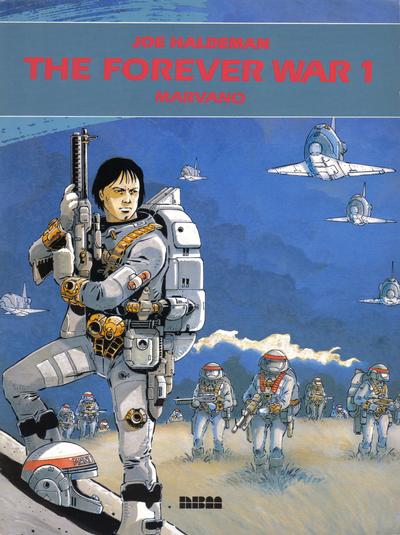  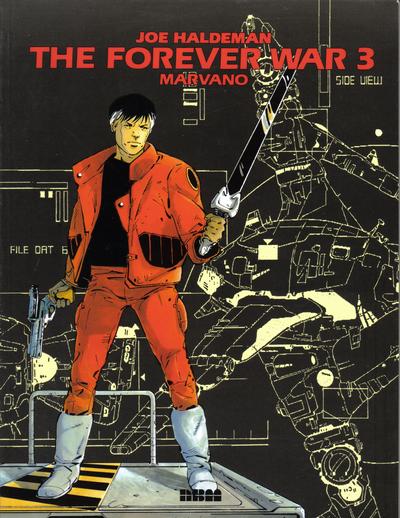  In 2017, the series was reprinted in 6 installments, by Titan, who also published Marvano's adaptation of the sequel, Forever Free.  The story features William Mandella, a physics doctoral candidate, who is drafted into the elite United Nations Expeditionary Force, which is made up of genius-level IQ soldiers. Here, Haldeman makes a stark contrast with Vietnam. In 1966, the department of Defense implemented Project 100,000, where the minimum IG requirement for enlistment was lowered to the 10th percentile of the Armed Forces Qualification Test. Some 300,000 men who would have normally been barred from military service were recruited and drafted (54% recruits, 46% draftees) and then given the same training as other recruits and draftees. The Johnson Administration referred to them as "New Standards Men;" but, critics and members of the military referred to them as the "Moron Corps." Those brought into the program included those who did not speak English, those who scored low mental aptitude, those of substandard education, as well as minor physical issues and over- ad under-weight. Performance records were monitored, but no special remedial training was given to the troops to boost educational levels to their higher scoring peers. Subsequent studies showed that veterans were more likely to have a poorer education, greater unemployment and marital difficulties than non-veteran peers and that the Project 100,000 were largely deployed to combat in Vietnam. Here, Haldeman reverses the situation, with the UN recruiting the highest scoring individuals, creating a military force of PhDs and technical experts. Book 1 deals with their training, both on Earth on on the planet Cerberus, beyond Pluto. Live fire exercises and training missions emphasize the danger, as well as the absurdity. After a lecture on 8 ways to kill a man, with an entrenching shovel, one recruit questions when they would only be armed with a shovel and why attack the kidneys, which the Taurans may not have, and not the head. The training instructor responds that they might be wearing a helmet and that the Taurans were known to have a similar physiognomy as humans and it was conceivable that they would have complex systems, comparable to human anatomy. No one really believes it. 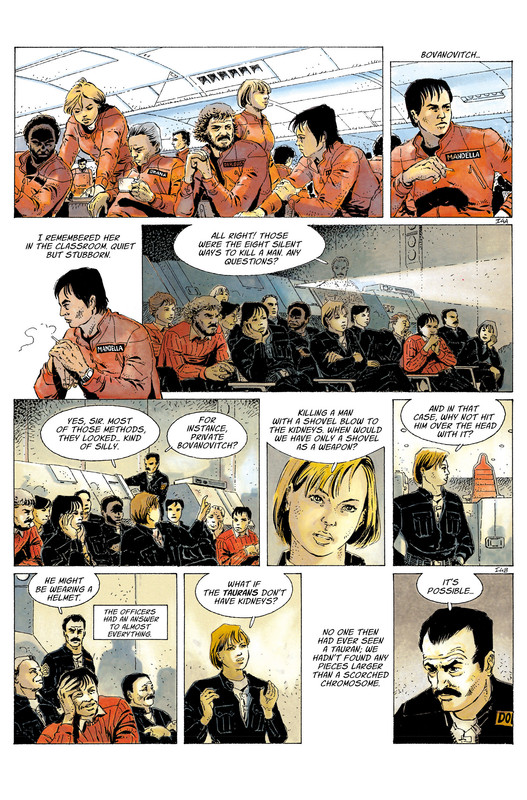 This is followed by news reports, exploring the history of the conflict and the departing UNEF fleet, to Aldebaran. A UNEF exploration vessel was attacked by a Tauran ship, touching off the war. The report notes that it will take 4 years to reach the location of the attack. Space travel over long distances is possible via collapsar jumps, where collapsar stars create portals, which allows ship to be accelerated to near-light speeds. However, the time dilation that results means that a 1 year tour equals decades of time, on Earth. The impetus of the war is the fear that the Taurans will take control of the portal planets, blocking interstellar travel. Time jumps, via traversing through black holes or collapsars, was discovered in 1998 and led to interstellar colonization, at lower expense than the Apollo Program. Tarining is carried out on cold weather environments, on Earth, but then the troops are transported to their ships, parked in Earth orbit. They are then transported to the planet Cerebus, for further training, a trip which requires them to lie in stasis chambers, while massive G-forces occur as the ship accelerates and decelerates. The journey takes three weeks and injuries occur, en route, due to conditions. Finally, they arrive and a transported down to the planet, where they meet their training officer, Octavio Cortez. he outlines their training. over the course of a month, they will erect a base, on the dark side of Cerebus, and remain isolated, while being attacked by robot drones. They will defend themselves, without medical evacuation or reinforcement. It us up to them to stay alive and 1 in 10 will die in training. 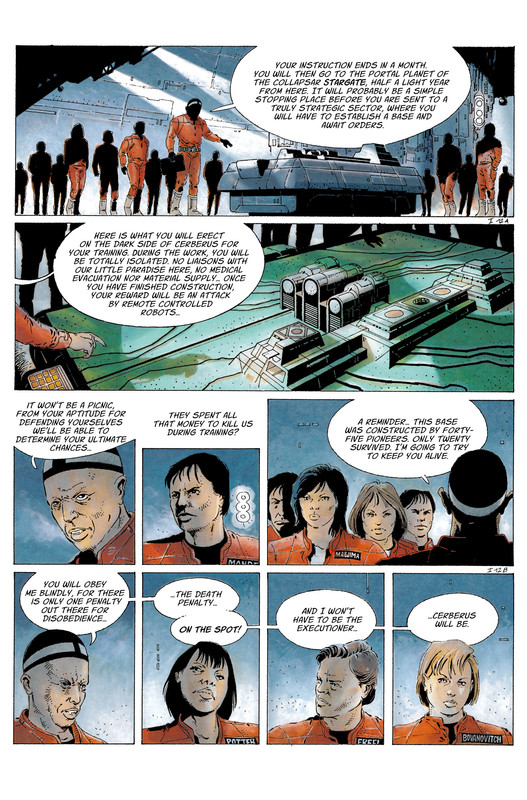 In many ways, this training is similar to the training received by Special Forces, as they worked at building base camps, in forward areas, which they then carried out in Vietnam, as part of the Civilian Irregular Defense Group program, which moved communities into fortified villages, to defend against VC attacks. These camps would be resupplied by helicopter and reinforced by Mike Force units, if under siege. In reality, the camps limited mobility of civilians and became targets of the VC and many Vietnamese felt more like prisoners within the camps, than citizens. Many would leave these camps and a few were overrun by VC, resulting in heavy casualties, before being secured again by friendly forces. Of Mandella's unit, 11 die in training and one is permanently maimed and must remain on Cerebus, as an invalid, as he could not survive the accelerations and deceleration forces, in stasis chambers. mandella gets to know female recruit, Mary Gay Potter (named for Haldeman's wife), who had been studying biology. They learn to intercept incoming attacks and deploy ground forces to fight off invaders. They succeed in their first attack simulation, but their second is a different story. Their missile defenses operate on a "dead-man switch," where release of the trigger switch fires the weapon. In the second attack, they face simultaneous attack, from opposite directions and a moment's hesitation leads to casualties. After the month's training, the unit boards their ship and spends 6 months travelling to Stargate, a planetoid, with a base, where they take on supplies and weapons, before departing to their assigned sector. They experience their first collapsar jump. When they emerge, they fire nuclear missiles at a Tauran ship. The commander of their ship gives them a briefing, before turning over to Sgt Cortez....  Despite their cold weather training, they are going to a warm planet, Aleph, near the star Epsilon, where the Taurans have a base. Their mission is to attack and bring back a Tauran, as prisoner. Their mission is similar to p the patrols run in Vietnam, in VC territory. Patrols were sent out to hunt and engage the VC, inflict as many casualties as possible and bring back prisoners for interrogation. Patrols often went out without encountering the enemy, unless they felt the odds favored them. When they did engage, the VC often fired from hidden positions and then quickly withdrew, unless they felt they had the upper hand. Prisoners were more often taken in villages, during search and destroy missions, than in the field, by patrols on the jungle trails. More often, prisoners were considered VC, until proven otherwise and few were ever cleared of that designation. Many were killed outright and most were poorly treated and even murdered, in front of journalists. 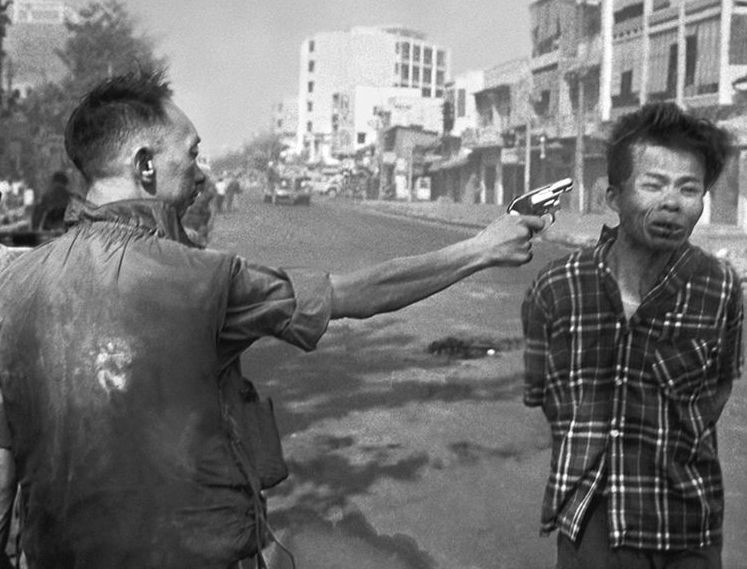 The troops touch down on Aleph and deploy their forces, across it's grassy plains.... 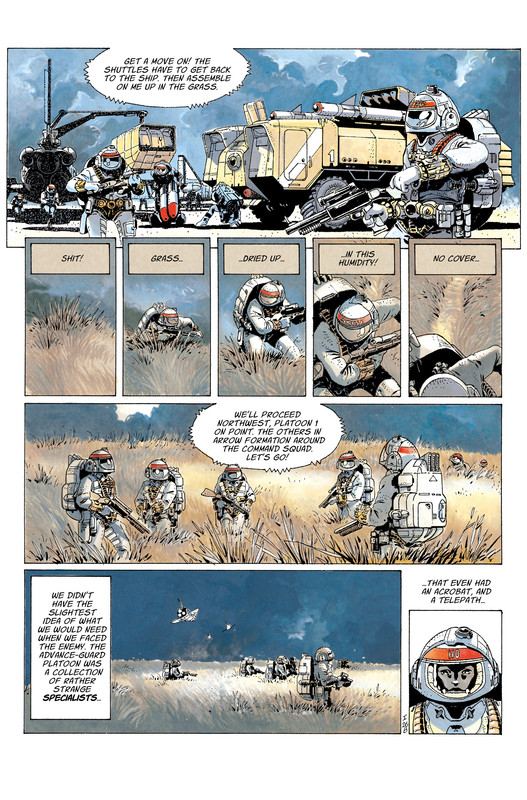 Potter reports in that they have spotted some animals and Cortez orders them to shoot to kill. Potter argues that the are just animals, but Cortez reminds them that they do no know what the Taurans look like. They fire on a beast, which resembles a sort of lumbering herbivore dinosaur, killing it. however, they discover that it was telepathic and a soldier that scored high on the telepathic testing scale is dead from a brain aneurism, caused by the animal's psychic projection. They do a quick roll call and discover that 4 other sensitives suffered severe headaches, but no casualties. The order goes out not to shoot the animals. They bivouac for the night and Mandella is on guard duty, nervous in the alien darkness. He is drawn by movement, which turns out to be another native herbivore. Mandella stares at it and receives feelings that the creatures don't fear them, but are curious. They continue their patrol the next day and encounter more animals, then Mandella calls in movement and they get their first glimpse of a Tauran...  They receive drone recon images of the Tauran base, where they see 30 more vehicles like the one the scout is piloting. They debate the numbers, when Hollister says there are hundreds, a message telepathically received from the herbivores. Cortez relays their orders. They will launch a surprise attack with a ship-launched nuke, in the upper atmosphere, to disrupt their communications. the troopers will then atatck the base and leave one Tauran alive, for questioning. Potter questions the order and Cortez reiterates that all but one are to be killed, not one taken prisoner and some killed. They move into position and Cortez calls in the drone strike. Once the nuke is set off, Cortez starts reciting a Robert Burns poem, which triggers a sudden bloodlust in the troopers and they go on a killing rampage.... 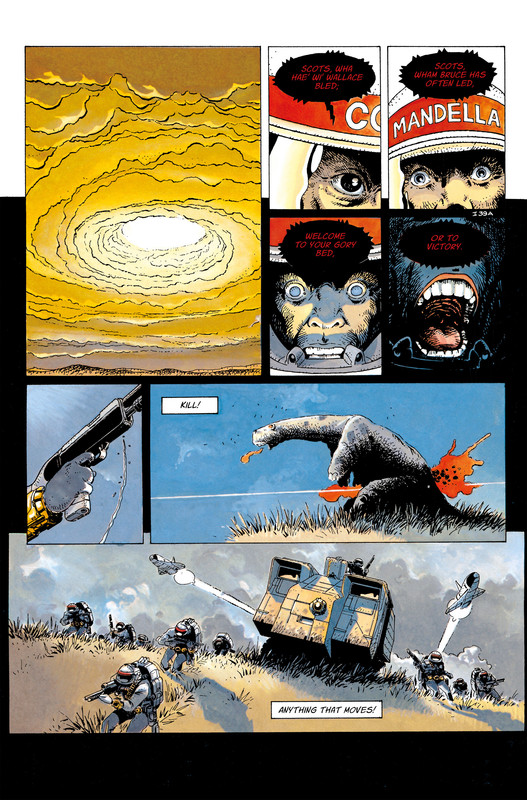 During the Vietnam War, when encountering enemy fire, it was not uncommon for troops to become enraged, especially after the wounding and death of their buddies. They often returned fire with violent methods and pressed their attack into villages, where they would clear buildings, often committing acts of violence against villagers, regardless of whether they were VC or not. In some cases, the violence was brief; in others, it led to the My Lai Massacre. Following the Tet Offensive, Charlie Company, 1st Battalion, 20th Infantry were deployed to an area near the Son My village. Men were briefed that the residents should leave for the market, by 0700 and anyone who remained was VC or VC sympathizers. Orders were given and/or interpreted to mean that women and children were to be considered enemy and killed. Troops landed after gunships hit the village, but the soldiers received no incoming fire. They still believed the village housed VC. Gunships reported fire near another village, My Lai. The soldiers entered a hamlet and found only women, children and old men cooking breakfast. They herded the villagers into the center and then violence broke out, as a soldier struck an old man. Killings and violence ensued. Soon, it spread to other hamlets. 70-80 villagers were herded into an irrigation ditch and soldiers opened fire. others were forced down a road, before GIs opened fire. Buildings were set alight and animals shot. Although actual numbers are hard to determine, it is believed that at least 20 women and young girls were raped. During the rampage, Warrant Officer Hugh Thompson Jr, who was flying close air support, noticed the bodies of the dead strewn about. he spotted bodies in a ditch and landed, asking a soldier to help get the civilians out of the ditch. They said they would help them out of their misery and Lt Calely said they were following orders. Thompson took off and witnessed the soldier shoot an unarmed civilian. He then landed his helicopter at another location, between other marauding GIs and civilians,, with orders to his crew to shoot anyone who tries to get at the civilians. he was able to get 12-16 civilian children out of a bunker, after an officer refused to aid them. Thomspon reported what he witnessed and compared the GIs to the Nazis, in WW2. Thompson received the Distinguished Flying cross for his actions to defend the civilians. Mandella and his compatriots kill everything in sight, including the herbivores, which leads to casualties with some of the psychic sensitive. They move in on the base and the Taurans emerge, without arms and without returning fire.....  One lone Tauran is left alive and tries to reach an escape rocket, and is targeted for capture, but kills itself. The post-hypnotic command is released and the soldiers come to grips with what they have done....  The ship escapes and they know that the next encounter with the Taurans will be different, as they will know how humans fight. Mandella is disgusted with himself and the human race. Mary Gay nearly goes insane. Book 2 opens with the unit back onboard ship, after suffering 14 casualties: 4 dead, one an amputee, and 14 driven insane by the mental conditioning and killing of the herbivores. They picked up 29 replacements at Stargate and are en route, when they receive an alert of a Tauran vessel that has fired a missile that accelerates faster than previously seen. The vessel is technologically advanced, due to the time dilation of the collapsar jumps, essentially from their future. 10 years time has elapsed on Earth, during their 2 years of military service. Cortez tells them that time shock may win or lose the war, as subjective timelines represent decades for themselves and the enemy, to react to events. The troops are ordered into their stasis chambers, as their ship will engage in a series of evasive maneuvers, at great acceleration. They have new accelerations tanks and they have ports implanted on their bodies and hook up their orifices to tubes, to regulate their body pressure. Despite the maneuvers, the ship is hit and there is a report of decompression in one of te chambers, where Mary Gay resides. Mandella and others unseal and rush there and he finds Mary Gay badly injured, but alive. Others are dead. They have footage of the new weapon and the captain makes to decision to abort their mission and return to Earth with the intelligence, to prepare for the next encounter with the Taurans. The troops return to Earth and are discharged, having served their tour and collected their back pay. 26 years have passed on Earth. They do not recognize the society. Mandella's younger brother is elder middle aged and his mother is 84 and dying,. Medical treatment is rationed by priority and she is classified Priority Zero, lowest of all. Mike, Mandella's brother fills him in. Employment is tightly controlled and the veterans' skills are 25 years out of date. Instructors are greatly needed and they will feel pressure to re-up. 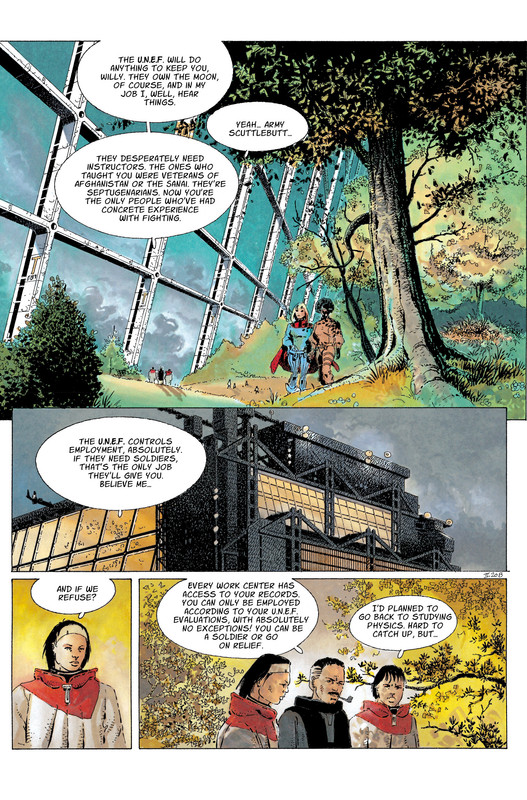 Upon returning to the US, many Vietnam veterans found it hard to find jobs. The economic impact of the war devastated the US economy, coupled with the OPEC oil embargo. Inflation was rampant and veterans found that civilian companies had little use for the skills of an infantryman or mortar expert. This was not exactly an unkown factor, as veterans of WW2 and Korea experienced similar issues.... Vietnam veterans also faced the alienation of having fought in an unpopular war, with images of napalm burned children and executed prisoners, with the stigma attached. Places like My Lai became synonymous with the war. Veterans learned not to bring up their service to avoid conflict or uncomfortable conversations. Substance abuse was heavy and the VA system was inadequate to deal with what became know as Post Traumatic Stress Disorder. William Earhart spoke of being the oldest student in his classes, with others afraid to talk to him or would ask ignorant questions, but give off the impression that they weren't really interested in understanding and lacked the context to really understand what occurred there. He also spoke of being 20, a decorated combat veteran and unable to make the purchase of a car, because he wasn't yet 21. He had to give his father the money to make the purchase. Then he was not allowed to buy his own insurance and had to be carried on his parents', until 21. he felt that his government had spat on him, not anti-war protesters. He found himself drawn to the Vietnam Veterans Against the War, after the bombing of Cambodia and the Kent State shootings. He spent years self medicating, with alcohol, before turning to writing poetry to exorcise his demons. Some veterans, unable to adjust, actually re-enlisted and went back to Vietnam, for another tour, because they understood things as they were, when they did not, at home. Others stayed in the military because it was an insulated environment and made careers of it. The unemployment rates were even worse for minority veterans. Mandella and Mary gay are interviewed, but find their comments censored and twisted into propaganda statements, by the government. Homosexuality was encouraged as a means of birth control and the populace is predominantly gay. Universities are closed off to them, due to their age. They can take welfare relief, which is subsistance, living in a drug-induced stupor, watching video programming. Taxes are high. William and Mary Gay find it difficult to continue their studies. William's mother is ill and denied all care. He obtains medicine and oxygen on the black market, but it isn't enough. Finally, Mike convinces them to rejoin the UNEF and come to the Moon, as instructors.... 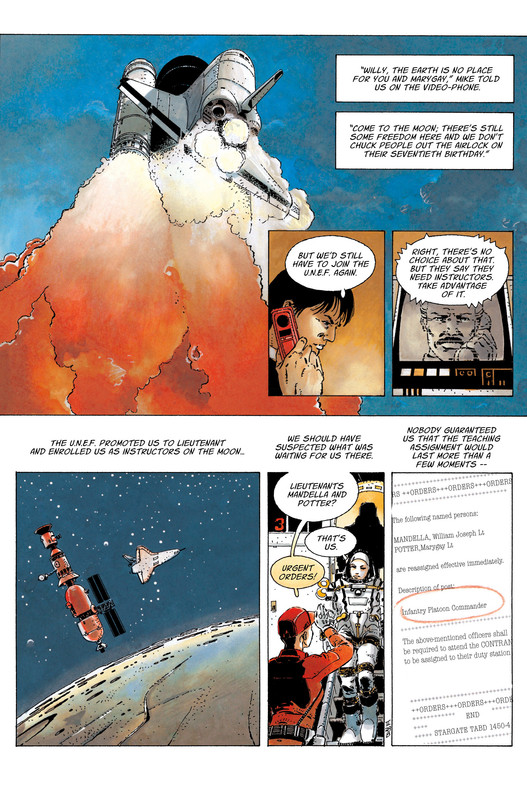 They are promoted to lieutenants and reassigned to combat infantry platoons, upon arrival. The UNEF lied to them. They re-enter combat and pilot shuttles on a mission, where they take fire and receive injuries, though their new suits seal around injuries. They end up as amputees....  During the Vietnam War, 65-70% of casualties to the US Marines, in 1965, were due to land mines. Over 120,000 were hospitalized with injuries and a like number injured, but not hospitalized. Amputations were common and the image of the disabled vet is prominent in protests, reunions, dramas, and photos and camera footage from the Vietnam Veterans Memorial. William and Mary Gay are transported to a hospital planet, called Heaven, where they will be fitted with mechanical prosthetics and spend 3 months recuperating from their injuries. The doctor advises them to lean on each other, for support. The prosthesis is actually a combination of synthetics and organic tissue, with metal bones and organic tissue over it. It does require treatment of localized cancers, in the process. William's relative time of service is now a century and he discovers that language has changed and their are descendants of humans who have never seen Earth. He and Mary Gay spend their time on an isolated mesa, in a a beautiful surrounding, until the service calls them back. They arrive at Skye station, dedicated to pleasure, where they eventually receive their orders. Mandella is assigned to Stargate. Mary Gay is not...  They protest and request to be assigned together, but are denied. They are resigned to their fate and make love, one last time, then Mary Gay leaves for her assignment. They will now be on divergent subjective timelines; forever apart. William watches her ship depart from their spot and contemplates jumping, to end it all....  Mandella now has to deal with survivor's guilt, as Mary gay is effectively dead to him. Many combat veterans go through this, recalling buddies lost, plagued by nightmares. Book 3 follows William, as he is promoted to major, given advanced training in military tactics and strategy, via VR and other learning aids. He is fed military history and philosophy and programmed with knowledge on waging war and killing, to his own disgust. He goes through battle simulations from different eras, flying Fokker DR7 triplanes and fighting with Shaka, in South Africa. William meets his new executive officer, who has access to his file, which says he could kill a Tauran in dozens of ways, but probably couldn't kill a human,. They meet their new command, composed of soldiers born in vitro, genetically engineered to be soldiers and all homosexual. The exec is asexual, due to the loss of pretty much all of his sex organs and llower half of his body, replaced by synthetics. he meets his second field officer, what would have been Field First Sergeant, but the duration of the war has made them top-heavy with officers. New soldiers were drafted for 10 years subjective time, with a two one thousandths of a percent chance at survival. The unit is being sent to a collapsar portal planet to establish a base and will remain there for 3 years, during which time they will likely be attacked. It will be the most distant outpost of the war. The ship's captain shows Mandella schematics of a new Tauran fighter, which looks nasty. Their hope is to arrive before the Taurans, dig in and build defenses. The soldiers are armed with swords and axes, which can operate in stasis fields, as technology has advanced enough to shield against projectile and energy weapons. Thus, fighting has regressed to armed hand-to-hand and melee combat. The ship's doctor has an alcohol-laced conversation with William, revealing that the soldiers call him the "old queer," because he is over 400 Earth years old and heterosexual. She drunkenly makes a pass at him to experience heterosexual intercourse, but William refuses, because she is drunk and she then passes out. They land and establish their base, but have no contact with the taurans. After 5 months, the stress gets to the unit and incidents start occurring. A soldier nearly kills a man who took up with his lover and is thrown in the brig. When he gets out, he tries it again. The exec wants to flush him out an airlock, which Mandella has the power to do, but doesn't want to exercise it. The soldier makes the decision for him and tries to attack him with a knife. William defends himself and the edge in experience subdues the man, before one of his officers holds a weapon on him. Later, William debates executing the soldier with his officers, when the soldier solves the problem again and attempts suicide. The doctor treats him and kicks Mandella out. She comes out to say he is dead, of cardiac arrest. She killed him. Then, they receive an alert that two tauran cruisers and 8 fighters have appeared and are between their orbital ship and the planet. It is the attack they have anticipated. The ship has to engage and leaves a lifeboat for the ground troops. The ship destroys one cruiser, but then they spot another ship emerging from collapsar jump and recognize it as a troop lander. Mandella deploys his troops to prepare to intercept them. Fighters destroy a couple of landers, but they overwhelm them. The orbital ship runs a kamikaze attack on the remaining cruiser and sets off a massive shockwave that hits the surface. Mandella and his remaining troops are inside a stasis field and set up a nova bomb to destroy the Taurans. The Taurans enter the field with axes, but the humans are more adept at the edged weapons they carry. They activate the bomb and push it outside the field, where it detonates and kills the Taurans. After 6 days, the radiation has subsided and they shut down the field and survey the area. Everyone is dead and they leave in the shuttle and link up with the lifeboat. They arrive back at Stargate some 350 years relative. They are met by identical soldiers, who turn out to be clones. They are told that the war is over.  It ended 221 years before. When Earth developed clones, they created a species that could communicate with the Taurans, who were a clone species. Finally, they had a mutual context for communication. Now, Stargate's purpose is to welcome home the returning veterans, who come in periodically, on different subjective timelines. They are told that veterans have settled on other planets, due to the changes at home. One called Middle Finger is favored by heterosexuals and William decides to go there. His exec and the doctor decide to join him. He receives his personnel file and finds a note from mary Gay, who returned previously. She says she is going to Middle Finger,  She and other veterans have purchased a ship and use it to make short collapsar jumps, while they wait for loved ones to return. It is a time machine, to bring them together, in the same subjective time. The story ends with a news report....  The story has a happy ending and so does Joe Haldeman's. Aside from becoming a noted and celebrated science fiction author (as well as other fiction and non-fiction), Haldeman taught writing at MIT. He and Mary Gay have been married for over 50 years and his work is considered one of the classics of science fiction, celebrated and read throughout the world. It is considered one of the best modern anti-war novels, from the experiences of a veteran, much like Eric Maria Remarque's All Quiet on the Western Front. It serves in contrast to Starship Troopers and other military sci-fi to say war is a stupid thing and often predicated on an inability to communicate with the other side. Here is a brief promotional clip of Haldeman, speaking about the book.... and a podcast interview, with Haldeman.... Haldeman is not alone in using his Vietnam experiences in science fiction. Author David Drake is also a Vietnam War veteran, serving in the 11th Armored Cavalry Regiment (The Black Horse Regiment), in both Vietnam and the invasion of Cambodia. His series hammer's Slammers features a mercenary armor company, using hover tanks and artillery to fight on alien worlds. Military aspects fill that work, as well as his Republic of Cinnabar Navy space opera series, modelled on the Aubrey-Maturin adventure novels of Patrick O'Brian, set in the Napoleonic Wars (themselves inspired by CS Forrester's Hornblower series), Drake's writing has been accused of being militaristic, which may be a bit unfair; but it is not about the horror of war as much as the adventure, though as seen through the eyes of professionals. That does tend to color your view of the missions they undertake. Within the comic book world, military sci-fi hasn't been a big element. There is Carl Potts' Alien Legion, though Potts was more interested in the adventure elements, again. It features a Foreign Legion, in space, with various races, a sort of melting pot, heavily influenced by Star Wars. As such, it mostly space opera and not exactly flushed with military authenticity. Christopher Moeller produced his Iron Empires series, at Dark Horse, Caliber and DC and his work shows a bit more attention to the military aspects, but in a mixture of cultures, also in a sci-fi setting. his world is an empire with a political and religious structure that is interwoven, more reflective of medieval Europe. it bears a strong resemblance to the Warhammer 40,000 series, with warriors in powered battle armor and heavy weapons, like knights of old, supported by less armored infantry and hover tanks and artillery. Moeller mixes things like samurai traditions, warrior monks, elite soldiers, colonial races serving with humans, noble houses and the like, in a mix of intrigue and horror, as the empire is beset by a parasitic alien invader which inserts "worms" into the cerebral cortex to control species, like the creatures in Star Trek II, The Wrath of Khan. In the segment, called Sheva's War, we also see creatures that capture victims, enveloping them in a membrane, which sustains their life functions, as they feed on them and/or control them. Imagine a leech-like creature that partially swallows a victim, which remains alive, in its mouth and is sheltered inside a cape-like skin flap. Moeller writes of soldiers and warriors, but also duplicitous politicians and vain leaders, as well as the body horror of the alien invaders, and the common people caught in the danger zone. Moeller is also not a veteran, but has done more research into past military cultures. Next, another 90s Vietnam-related comic, as we look at Ms. Tree Special #10, (formerly Ms tree Quarterly, but turned into semi-annual specials, for issues 9 and 10). The story features a mystery of Vietnam and an MIA soldier. |
|


